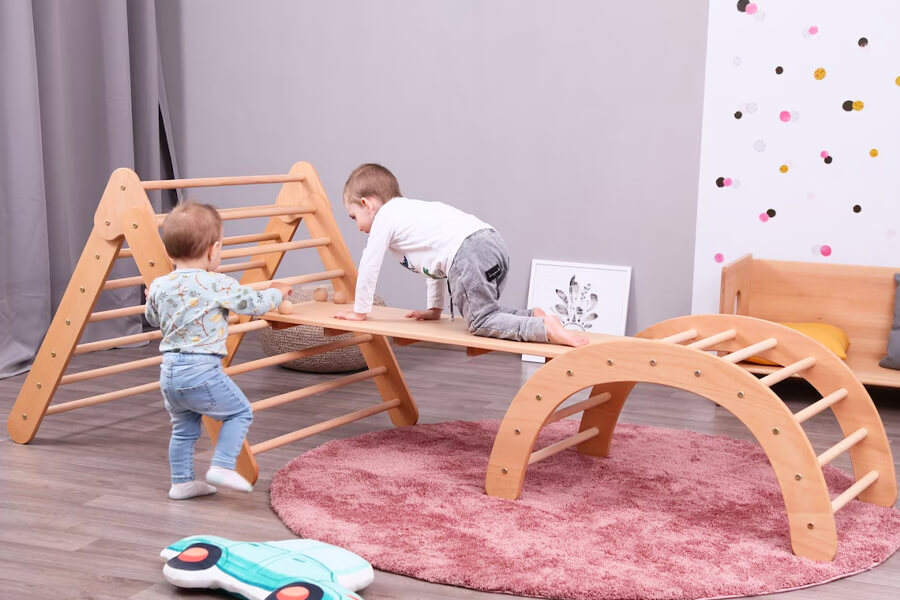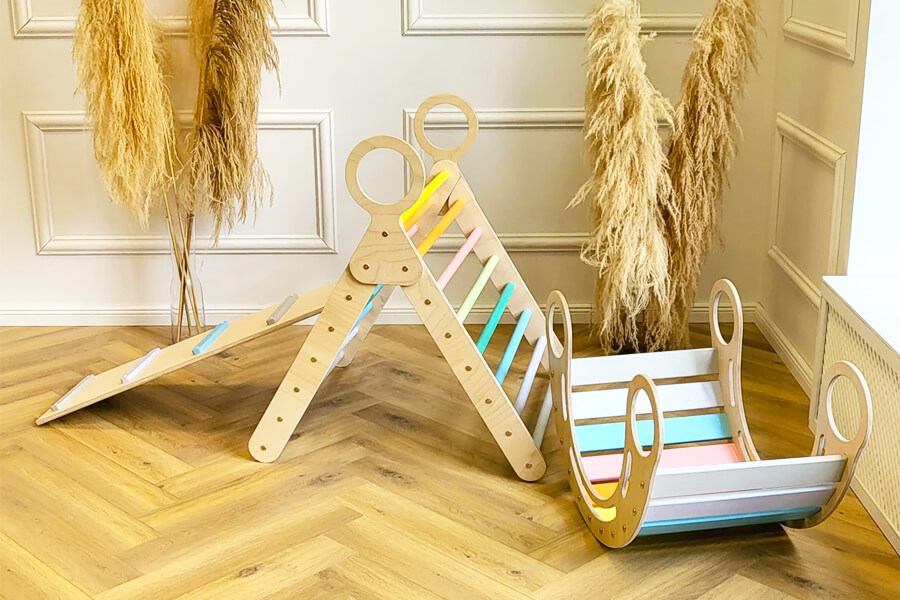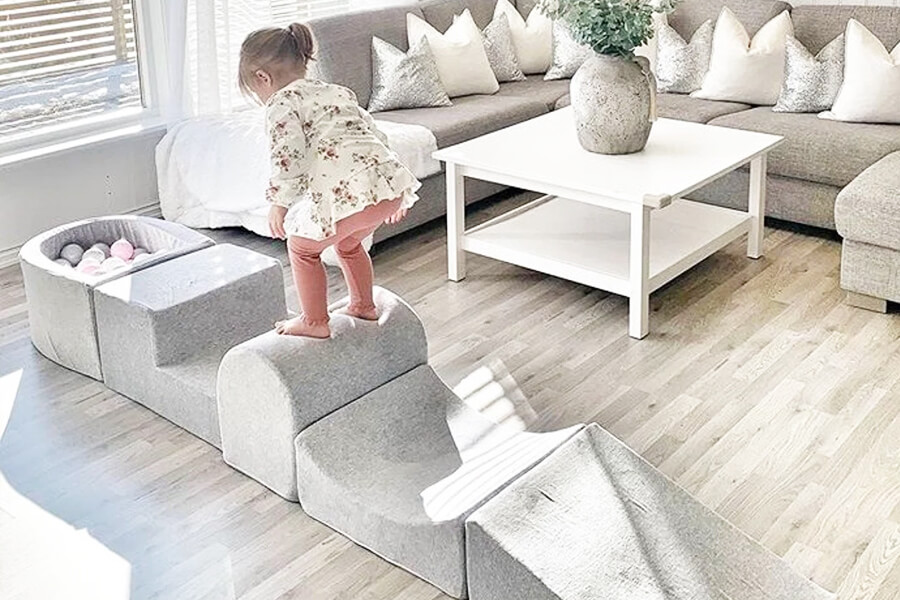Montessori climbing toys are a great way to encourage indoor physical activity. They help develop gross motor skills and coordination, and are perfect for rainy days or when the weather is too hot to play outside. There are a variety of different types of Montessori climbing toys available, so you can find one that is perfect for your child’s individual needs and interests.
Understanding Montessori Climbing Toys
Montessori climbing toys, rooted in the Montessori philosophy of fostering independence and hands-on learning, are meticulously crafted to bolster a child’s gross motor development. Typically constructed from durable, child-safe materials, these toys offer a myriad of climbing challenges. Whether indoors or outdoors, they provide children with an engaging way to hone their physical skills. From ladders, cubes, and ramps to slides and more, these toys are more than just playthings; they’re tools that foster coordination, balance, and strength.
The Advantages of Montessori Climbing Toys
When it comes to toys, Montessori climbing toys are some of the best. Here are some benefits of these types of toys:
-
They promote physical activity
At the heart of Montessori climbing toys is the essence of movement. They provide a dynamic platform for children to engage in physical activity, enhancing their gross motor skills in an enjoyable and secure environment.
-
They help develop problem-solving skills
Climbing isn’t just a physical endeavor; it’s a cognitive one too. As children navigate these toys, they’re tasked with coordinating their physical actions with mental strategies. This harmonious blend of body and mind sharpens their problem-solving capabilities.
-
They boost confidence and self-esteem
The journey of climbing, with its inherent challenges, offers children a chance to conquer obstacles. Every small achievement on these toys translates to a significant boost in their self-worth, instilling confidence and fostering a healthy self-esteem.
-
They Enhance Spatial Awareness and Coordination
Montessori climbing toys are intricately designed, requiring children to gauge distances, understand spatial relationships, and coordinate their movements accordingly. This active engagement not only refines their spatial intelligence but also improves their hand-eye coordination, preparing them for more complex tasks as they grow.
Selecting the Ideal Montessori Climbing Toy
There are so many different factors to consider when choosing the right Montessori climber toy for your child. First and foremost, you need to make sure that the toy is age-appropriate for your child. Climbing toys are typically meant for kids aged 3 and up, so if your child is younger than that, you might want to look at other options. Another thing to consider is the size of the toy.
You need to make sure that it is neither too big nor too small for your child. If it is too big, it may be difficult for them to move around, and if it is too small, they may be able to climb on it but not get down without help. Finally, you’ll want to think about how much use your child will get out of the toy. If they’re only going to play with it for a short period of time, you might not want to spend as much money on it. However, if they’re likely to use it often, you’ll want something that’s built to last.
The 10 Best Montessori Climbing Toys
There are so many Montessori climbing toys out there that it can be hard to choose which ones are the best, but we’ve compiled a list of the top 10 Montessori climbers. From simple rockers and stackers to more complex climbers, there is something for everyone on this selection. Montessori climbing toys are a great way for kids to get active and have fun. They are also great for developing coordination and balance. If you are looking for a toy that will help your child develop physically, then a Montessori climbing toy is definitely worth considering.
-
Pikler Triangle
The Pikler Triangle, conceived by Austrian physician Emmi Pikler, is a versatile play equipment with a three-sided frame featuring internal rungs. Designed for safe climbing and exploration, it’s a favorite in early childhood settings and homes aiming for a stimulating environment. Suitable for both indoor and outdoor use, these triangles can be store-bought or DIY. They promote gross motor skills, imaginative play, and problem-solving, making them an excellent tool for fostering physical activity and creativity in children.
-
Pikler Arch
Pikler Arches are one of the best ways to encourage your child’s natural love of movement. They are perfect for indoor or outdoor use, and can be used in a variety of ways to encourage gross motor development. From climbing and crawling, to swinging and sliding, Pikler Arches provide endless opportunities for fun and exploration. And, they’re also great for developing strength, coordination, and balance.
-
Ramp
The best ramps climbing Montessori are those that are specifically designed for children. They should be safe and easy to use, so that kids can enjoy the fun of climbing without any risk of injury. The best ramps will also be lightweight and portable, so that they can be easily moved around and set up as needed. Look for ramps that have smooth, nonslip surfaces and offer a variety of different inclines to challenge kids of all ages and abilities.
-
Swedish Climbing Walls
Swedish climbing walls are an excellent choice for optimizing space in small environments. A Swedish climbing wall is often a three-sided ladder with rungs spaced out like the Pikler triangle. This may suit families with older children who are ready to reach new heights. By having a Swedish climbing wall, it will give the children something to challenge themselves with and also promote physical activity.
-
Multidimensional Climbers
These climbers are designed to encourage children to use all their senses as they explore. They offer a variety of textures, colors, and shapes to stimulate the mind and body. Children can climb, crawl, swing, and slide their way to new heights with these climbers.
-
Jungle Gyms
Jungle gyms typically consist of a series of platforms and bars that children can climb on and swing from. This type of equipment is often found in parks and playgrounds, but can also be purchased for home use. Jungle gyms are a great way to encourage active play and exploration in young toddlers.
-
Modular Foam Climbers
Montessori-inspired modular foam climbers are made up of large, colorful foam blocks that can be configured in various ways, providing endless opportunities for exploration and fun. These versatile pieces can be used to create all sorts of different climbing and crawling challenges, depending on how they are arranged. Modular foam climbers are also a great way to encourage social interaction and teamwork, as children work together to navigate the obstacles.
-
Slide
Slides are a classic favorite among children, and for a good reason. They offer the thrill of a swift descent, teaching kids about gravity and balance. Montessori slides, often made of wood, are designed to be safe and appropriate for young children. They can be standalone or attached to other climbing structures, providing a smooth finish to a climbing adventure.
-
Cube
The Montessori climbing cube is a multifaceted structure that offers various challenges to little explorers. With its open design and multiple sides, children can climb in, out, over, and through, making it a versatile piece of equipment. It aids in developing spatial awareness, problem-solving skills, and gross motor coordination. Often made of sturdy wood, the cube can be a central piece in a Montessori playroom, offering endless opportunities for imaginative play and physical activity.
-
Play Couches
Montessori play couches are an exciting addition to any child’s playroom or bedroom. These special couches are designed to provide a comfortable and safe space for children to play, explore, and relax. Play couches are a great way to encourage creative play and provide a cozy place for naps and quiet time.
When to Introduce Montessori Climbing Toys
While the optimal age for Montessori climbing toys might vary, many children can start interacting with them as early as 6 months, albeit in a limited manner. At this tender age, babies are developing their gross motor skills and beginning to understand their environment.
Introducing them to climbing toys, even if it’s just touching or leaning against them, can stimulate their senses and curiosity. By 18 months, as their activity levels and eagerness to explore amplify, they are more prepared to fully engage with these toys. Climbing toys not only serve as a source of fun but are instrumental in enhancing motor skills, coordination, and balance.
How much do Montessori climbers cost?
Montessori climbing toys, with their diverse designs and materials, come at various price points. Typically, a quality climber ranges from $100 to $300. The cost is influenced by factors like the climber’s height, the number of platforms, and additional features like stairs or slides.




